Surfboard models and the relentless pursuit of perfection
“Every time I change the position of a legrope plug I've gotta give the board a new model name!” Though Chris Garrett is laughing as he says this I can sense dismay in his voice - many a serious word said in jest and all that. The cause of Chris' consternation is the model system of surfboards. In 2016 there's an expectation that shapers present their boards as 'models': fixed, identifiable, and replicable shapes that customers can choose from.
Surfboard models supposedly simplify the system, they remove customer guesswork. Yet for Chris Garrett, who “mass produces his surfboards one at a time” - his line not mine - the model system doesn't necessarily work that way. And when I began to speak to other shapers I found he wasn't alone.

“Customers can have their car painted any colour they want so long as it is black,” said Henry Ford about his Model T Ford, the world's first mass produced car. Historians believe old Hank was being playful, in later years the Model T came in red and blue, however those words betray his revolutionary thinking. Ford invented mass, standardised production with over 16 million identical Model T units rolling off Ford's Detroit assembly line. It was cookie cutting on an industrial scale and Henry Ford subsequently became one of the most influential people of the 20th Century.
Ford's thinking caught on and mass production rapidly spread, from food to building materials to clothes...and even to surfboards. In the 1920s the few surfers that existed in Hawaii and California had to make their own boards by hand. This changed in 1930 when Pacific Home Systems, a building company from Los Angeles, swung left and turned their attention to surfing.
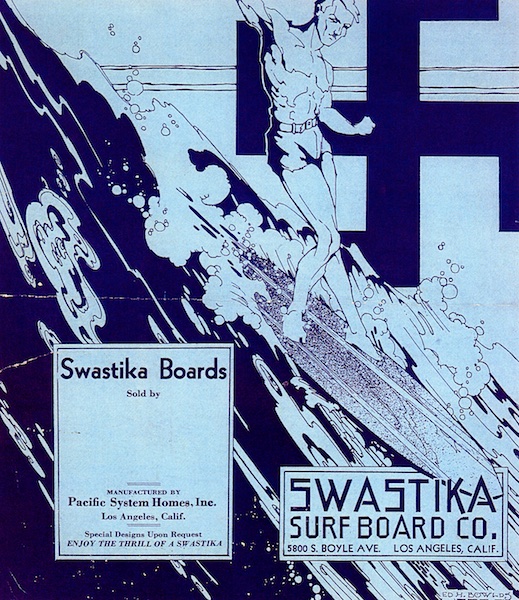 Pacific Home Systems constructed their boards from laminated redwood and balsa, joining the pieces together with waterproof glue. As each board rolled off the production line it had a swastika symbol – sanskrit for well being - burnt or printed onto the bottom. Thus the improbably named Swastika model became the first commercially produced surfboard, though when the Nazis goose-stepped into Poland Pacific Home Systems wisely changed the name to the infinitely sunnier 'Waikiki Surf-Board'.
Pacific Home Systems constructed their boards from laminated redwood and balsa, joining the pieces together with waterproof glue. As each board rolled off the production line it had a swastika symbol – sanskrit for well being - burnt or printed onto the bottom. Thus the improbably named Swastika model became the first commercially produced surfboard, though when the Nazis goose-stepped into Poland Pacific Home Systems wisely changed the name to the infinitely sunnier 'Waikiki Surf-Board'.
Compared to the Detroit assembly lines, the Waikiki board was a rudimentary affair; it was available in six sizes, each having a square tail, near-parallel sides, and a round nose. They were made in production runs of 15.
In the 1940s balsa superseded redwood, which was itself superseded by foam in the late-50s. The qualities of foam, being easy to work with and create complex shapes, made it ideal for customisation – the opposite of mass production. Yet still the urge to standardise crept in, only this time with a twist. In 1963 Hobie Alter created the first celebrity model surfboard, the Phil Edwards signature model.
Signature models created a brand within a brand, capitalising on the surfers' fame to sell units. Hobie Alter subsequently offered signature models for Joey Cabell, Joyce Hoffman, Gary Propper, and Corky Carroll. And though the boards had consistent features, they were ultimately hand shaped and suffered inconsistency in the detail.
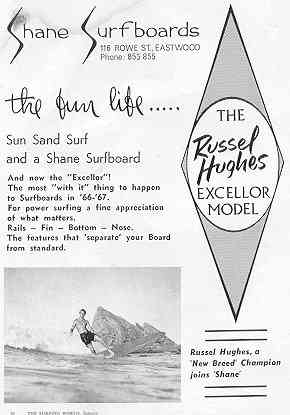 Here in Australia, Shane Stedman followed Hobie's lead with the Russell Hughes 'Excellor' model. Yet, again, they were hand shaped and though the differences between boards were minor they'd effect performance, hence nullifying the standardisation. It wasn't until 1970 when Shane released the appropriately named Standard that surfboards achieved an element of duplication.
Here in Australia, Shane Stedman followed Hobie's lead with the Russell Hughes 'Excellor' model. Yet, again, they were hand shaped and though the differences between boards were minor they'd effect performance, hence nullifying the standardisation. It wasn't until 1970 when Shane released the appropriately named Standard that surfboards achieved an element of duplication.
“The price of surfboards was heading toward $100 and it was causing everyone anxiety,” says Shane explaining the motivation for the Standard. $100 was how much a chippy – a carpenter - earned in a week and it became a proxy guide for board prices – such were the times. The Standard was a way to reduce costs and keep boards under the $100 milestone.
Shane achieved that by blowing foam in a mould the approximate shape of the finished board, which came in two sizes: a 5'10” round tail and a 6'3” square tail. The foam still had to be hand finished but, says Shane, “instead of 1½ hours per board it took 20 minutes.”
The Shane Standard was a radical innovation, however the new boards took some getting used to. “At first, surfers didn't like the stringerless look,” says Shane, “so we strung black cotton down the centre to imitate a stringer!” The memory causes Shane to convulse with laughter.
The Standard was the closest the surf world had got to Model T replication and the public loved them. At their peak Shane had a team of shapers pumping out 200 Standards a week all for less than $100 a pop.
$100 a pop? An unfortunate choice of words...
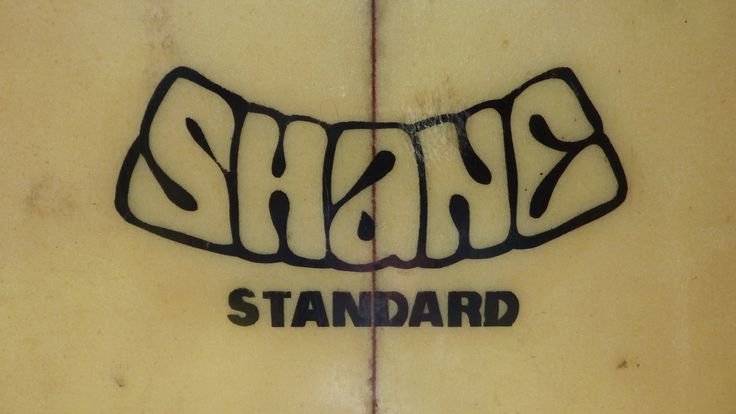
In the early 70s, surfboards were a cottage industry and artisanal skill was emphasised. While the boards sold well the blowback from purists was quick and sharp, the boards were coined 'popouts' while his principles were brought into question. “Yeah we copped grief. 'Course we did!” Shane bellows.
“The shaper was supposed to have his arse hanging out of his pants,” says Shane of the critics who railed against him. “Shapers were supposed to provide a service for no money. You know that whole tortured artist thing? That's how they wanted shapers to live.”
“We worked 24/7 on those surfboards and the people opposed to them were a small but vocal minority.”
You don't have to spend long in the company of Shane Stedman to understand he's no tortured artist or that he'd ever be a victim to other people's expectations. So how did he react to the criticisms? “Ahhhh, I couldn't have given two stuffs,” says Shane before delivering another round of roaring laughter.
Pioneers get the arrows and settlers get the land, so the old saying goes, and this was the case with modern surfing's first attempt at standardisation. “We were innovators,” says Shane of his pioneering efforts. It'd take a while, around 25 years in fact, for Shane to be proven right. During the intervening quarter century shaping machines would be conceived and created, while public perception would shift from repulsion to acceptance.

It's impossible to pinpoint when public acceptance of machine shapes occurred, but around the turn of the millennium a choice of moulded and machine shaped boards hit the market. First Salomon S-Core, then Surftech, and in 2004 Firewire began operations. The machine shape stigma was slowly eroding as surfers realised the benefits of replicable shapes. The popularity of these boards gave traditional shapers – those custodians of artisanal skills – little choice but to also start thinking in terms of models.
Stuart Paterson has been shaping at Cronulla for over thirty years, the last fifteen under his own label, PCC Boards. “At first there was a resistance to machine shaping,” says Pato, his wild hair flecked with foam dust. “The 90s were the dark ages really, but people accept computer shaping now, and rather than stifle creativity it's allowed shapers to create and replicate a wide variety of shapes.”
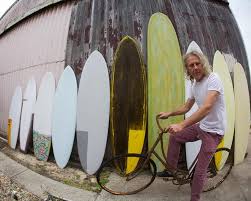 For Pato, creating surfboard models – and he's a got a few - is a way of file keeping as much as anything else. “It's a system of keeping track of what I've created so customers can come in and get something the same, or maybe something similar, the next time around. Otherwise I'd just have a long list of numbers to refer to.”
For Pato, creating surfboard models – and he's a got a few - is a way of file keeping as much as anything else. “It's a system of keeping track of what I've created so customers can come in and get something the same, or maybe something similar, the next time around. Otherwise I'd just have a long list of numbers to refer to.”
While talking, Pato and I riff on the idea that giving boards various model names is similar to categorising music by different genres. “Imagine walking into a record shop and it was just wall to wall vinyl, none of it categorised, but you were looking for, say, punk or hard rock. Where would you start?”
The starting point, at least for Pato, is the model name and from there he can make variations, either on screen or after the blank is cut, if the customer wants them. Call them sub-genres if you wanna stretch the music shop metaphor. “From the model's master file I create a personal file for the customer so we've got a starting point for the next visit. They can get exactly the same board or a similar one with variations.”
It's clear then that surfboard models, at least how Pato uses them, are fluid. Rather than the rigid mass produced output of Surftech, Salomon, and Firewire, modern computer shaping provides shapers such as Pato a degree of flexibility while also exerting quality control.
Before I leave I ask Pato if other shapers use the model system in a similar way to himself. “I've no idea” says Pato earnestly. “But I have an inkling they might.”
A cursory survey conducted by Swellnet revealed that many shapers do indeed work similar to Stuart Paterson. Rather than adopting a Henry Ford-style of mass production they've subverted it by using models as a starting point then adjusting them for their regular customers. An exception is Torquay's Corey Graham, notable because he rejects the model system. If walking into a surfboard factory is akin to walking into a record shop then Corey Graham's is the jazz section. Freeform jazz, played in the 50s tradition without regular beat or structure.
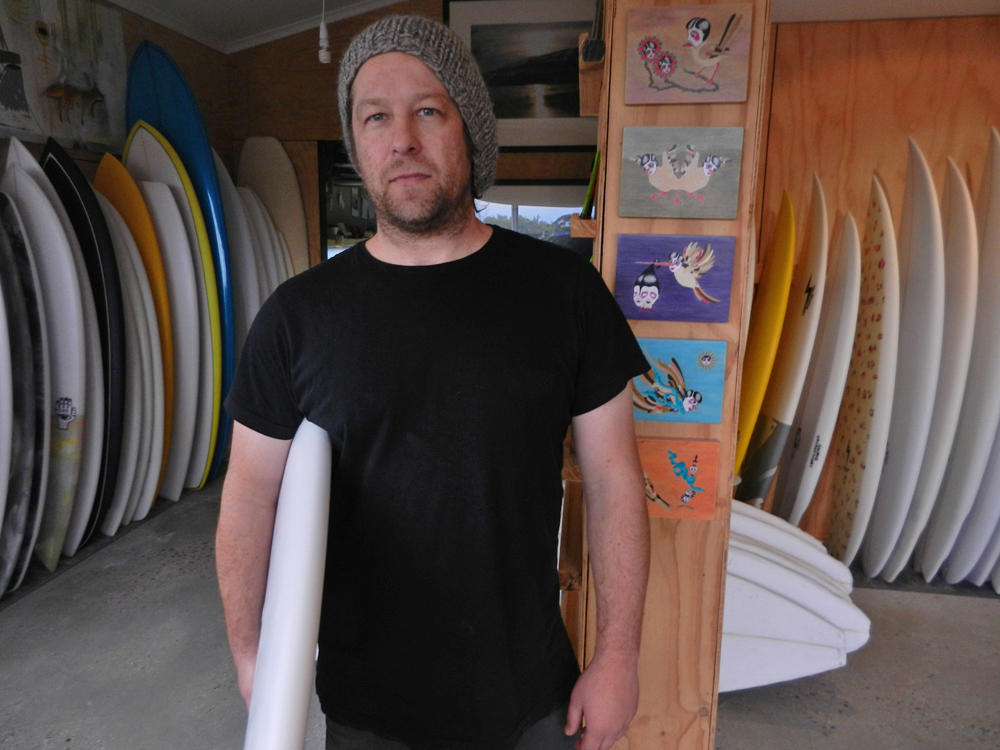 “Everything I do is hand shaped,” says Corey, “but I very loosely shape upon models. To me models are a premise, a thought, or an idea.” All Corey's customer know this, and it seems they love him for it. He's a shaper who's carved out a special niche as a shaping virtuoso, though the freewheeling jazz analogy only goes so far. Corey is also a strict bookkeeper.
“Everything I do is hand shaped,” says Corey, “but I very loosely shape upon models. To me models are a premise, a thought, or an idea.” All Corey's customer know this, and it seems they love him for it. He's a shaper who's carved out a special niche as a shaping virtuoso, though the freewheeling jazz analogy only goes so far. Corey is also a strict bookkeeper.
“I keep a record of everything I do, everything that people have ordered,” says Corey. “I can recreate a board with all the variations a customer wants.” Like Chris Garrett, Corey “mass produces his surfboards one at a time” but he still relies upon a system to give order to the process.
However, Corey's resistance to models has put him at odds with the retail system. “Yeah, it's been hard,” says Corey. “There's just that expectation that boards are sold by the model now. Some people don't know how to approach my boards because I don't work that way.”
He's not being purposefully obdurate as much as he's being true to his beliefs. “When a board model gets made it's like putting a full stop at the end of its life, and I don't want that. I don't want the story to end. You've gotta leave room for evolution, growth, for further versions of that board.” In other words, that sax solo can always be improved.

Both Corey Graham and Stuart Paterson are regional shapers, they service their local beaches and a smattering of surfers that live beyond them. The next tier up are the large scale board manufacturers that sell nationally and internationally. These companies can best capitalise on the model system - at least how Henry Ford envisaged it - as their customers most often buy off the rack and rarely speak to the shaper beforehand. They're also the companies most likely to sponsor pro surfers.
Models are now so ubiquitous they appear as a regular statistic on all WSL webcasts. It sits alongside a surfer's other vitals such as age, height, and nationality. Yet when Joe Turpel says Mick Fanning is riding a Ducks Nuts – that's one of Mick's models and a big seller for DHD – just how close is it to the model being sold off the rack?
“Sometimes it's the exact same board,” says Darren Handley matter-of-factly. “Mick has even done that; at Bells one year he pulled a board off the rack at the Rip Curl shop and rode it. He's done the same at the factory here.”
“Other times,” says Darren, “He'll be riding the model but with tweaks for the particular wave. For instance, if J'Bay gets 3-to-5 foot he'll be on a Ducks Nuts that'll be the same as one off the shelf except with a slightly pulled tail.” The explanation is similar to the way regional shapers work: the 'model' as a starting point with individual customised changes.
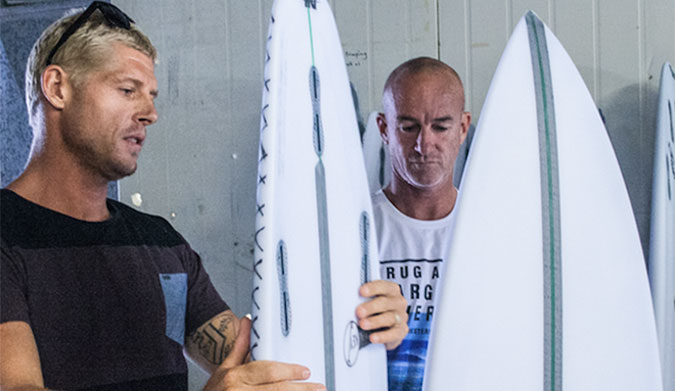
Mick and Darren
Often webcast viewers hear that surfers have spent the off season working with their shapers, yet if they're only riding stock boards, or boards very close to it, then what work is there to do? I put this question to Darren.
“Look at someone like Jack Freestone,” he replies by way of example. “He rode a DX1 last year through the Qualifying Series, and all year he rode pretty much the exact same board. That's because it's a board made for beachbreaks. Now he's on the CT he needs different boards for different waves.”
“Also,” says Darren continuing the point, “CT surfers might get 50 boards exactly the same, yet only three work for them.” It's hard for average punters to get their heads around the hair trigger sensitivity of a full time pro. “It could be the wood used in the stringer,” says Darren explaining the subtle differences. “The way the foam was blown, or even just their attitude on the day they rode the boards.” He's not being dismissive, mindset is crucial for professional athletes.
Travis Lee spent many years working for Channel Island and is now Firewire's marketing manager. He's had similar experiences with his riders. “Stu Kennedy sometimes rides exact stock models of the Sci Fi in his heats,” says Travis. While on the other hand Kelly Slater is less likely to ride a model with the same dimensions as an off-the-rack board.
“Even though Kelly may have had a magic board that we froze in time and launched as a model, he definitely isn't done with it.” Kelly Slater's eternal quest for perfection touches every facet of his life: mind, body, diet...and his surfboards too it would appear. His desire to constantly evolve largely prevents him from settling for an off-the-rack model. “Kelly's constantly working to see if by changing variables he can make it even better,” says Travis and it doesn't sound the least bit surprising.
What does sound surprising is that Firewire are one of the world's largest surfboard companies, they're surfing's heir to Henry Ford's mass production, yet Kelly's desire to constantly improve his boards sounds much like Corey Graham's justification for staying outside the model system: the desire to keep evolving and developing ideas.
In truth it's a desire possesed by most shapers, even those who've wholeheartedly adopted the model system - 'new season models' are more than just cynical marketing devices, they're the next stop in the design continuum. It's a never ending sequence of creativity that fits awkwardly with mass production.
By any measure, Shane Stedman truly was an innovator but what's evident now is that standardisation in surfboards isn't enough. A large percentage of surfers - from pros such as Mick Fanning to anonymous locals - not only want consistency in their surfboards but they also want them to evolve and improve. That's where surfing is at right now. So while the model system has indeed simplified matters for the customer, it's more complex than rolling surfboards off the assembly line like old Model T Fords.
Visit Chris Garrett's website
PCC Boards are updating their website but you can get them on Instagram
Corey Graham's Insta page is splendid corner of the internet


Comments
Interesting, relevant , enlightening , entertaining and well written.
Swellnet again making it seem all too easy too hold an audience.
Good article.
Coincidentally I was having a bit of a chin wag yesterday with someone who's been in the game as long as anyone and a couple of things stuck. He said that if a shaping machine was available all those years ago, any shaper/designer in their right mind would have jumped on it and avoided a lifetime of the RSI problems that come with years of mowing foam. A machine is simply a tool, nothing more, albeit a very precise one when used properly.
And maybe more pertinent, he said that a lot of the new people coming through calling themselves designers are taking old shapes, breaking them down and copying them, passing them off as their own and then bagging out long time designer/shapers for using machines and production lines for having lost their 'soul'.
Oh the irony:)
That was long! I had my eyes opened when I bought a model off one of the big Qld shapers and liked it. After a year it was knocked around and I'd also put on a bit of weight so I bought exactly the same board but an inch bigger. They looked almost similar yet rode differently and I didn't like the second one.
I'm not sure why it was but my theory is the rocker was flatter because of the longer length which made it a very different board.
That's the problem with models, they don't always scale up or down very well and it's ususally because of the rocker changing. If you stick to the same size it's all good. The same thing happens with Firewire if you ride the same model, even the same size, but different construction. They're sorta the same but sorta different.
Shane Stedman is a legend!
Great article ... We need both but once you change a metric, the model is different in more ways than one. Shanes's strategy was spot on. The next phase in this process, is to implement total quality management, to really refine the manufacturing process and reduce costs yet keep quality consistent or improved. We will always have custom and will always need it. That is the seed for the next phase, the model.
I'm not sure about all these "models".
Isn't it just a marketing ploy to make us all think were getting something new ?
The larger producers want to cut costs so people order a model - usually online - rather than actually talk to their shaper, who then shapes what is right for them as a surfer.
Never purchased an off the rack, churn and burn board and probably never will.
Keep the designer/shapers in a job and purchase direct from a guy who wants you to surf the best you can, on a board he makes specially for you - then he gets a repeat customer. It may have a model name, and is usually a machine shape but it will be specificly shaped for you. makes me feel good anyway :)
That's my 2 cents worth.
Yep, that's pretty much my experience OHV. The guy who shapes my boards starts with a 'model' and then adjusts it, sometimes a little, sometimes a lot, sometimes turns it into an asymmetrical. But he's using the model system, the same system that promised mass production, except he's adding customisation to it. Best of both worlds and all that.
I never buy off-the-rack models for a similar reason to you. However, one regional level shaper I spoke to said he doesn't mind that they exist. When a new customer comes in he asks them what they've been riding. His database has the dimensions of just about every model from every (reasonable size) manufacturer. Therefore he knows what dimensions the customer was riding even better than they do.
When it comes to building a better board for them he asks what they want and he uses that past board as a starting point. It's almost like open source software.
Exactly the same with my shaper. Has a few standards for the various shapes then after discussing, height, weight, waves, age (old in this case), what boards you have been riding. He then talks through on a stock model what he will do to customise it to suit the individual needs, then adjusts it with the guy on the computer (who also blows the blanks) and the shape is born. He keeps all your boards on file and as you say any boards that come in for ding fixes, he checks out if there is anything he doesn't know or likes and puts that in as well. They can duplicate anything from anybody these days and all of it is known to the guys who have been around long enough. A lot of the pro model boards he examines are really simple and straightforward.
I once a comp skeg on SHANE.HOHENSEE,Mac Tavish,DVS,DERBY & SKY. Was not a board I needed to surf next level.Start afresh-standingboards are brilliant on 1/4 of wave+trough/180*face/long rides but shallow barrels ( by default future will remain less wavetime more aerials). Bodyboards utilise 1/2 wave by being able to throw 360* with lip,less buoyant partial-full submersion take off and deeper barrels. We/you/me the Bodybasher limited only by lack of imagination-Feels the complete wave surfing over lip off wave, bouncing off boards, along trough but now back underneath dolphin popping complete inside barrel rotations(either direction),ceiling time even walking/cycling on face and coffin rides. Yes OK laugh! So I am decrepit by age and lack courage but any lightweight trained grombasher could rip twice this and more. Versatility(no- planes/ flippers)is secret! Surfing 8ft rail retracting to finger tip control or 1" hook to 3ft powerball all in less than a sec. 20 suction paws for ceiling time,temp control, guidance systems,shock absorbing,intake/outake valves,ballast transference even 1/2/3 segmented caboose frame ride.So what if my croaky loudhailer never stopped any drop- ins resulting in 500 dings or more,many repair themselves thanks to Huey. PS. Yes I read whole swellnet article and correspondence and enjoyed as always. This reply is meant to compliment by way of understanding what the human machine is capable of, if any wish to synthetically duplicate that, good luck..many try. One small hang 5 for skeg..A giant leapfrog for bodybasherz. Hooroo!
Holy fuck, what sort of acid induced mumbo jumbo are you spruiking? Musta been a good time in the 60's that it seems you may never have come back from, or maybe..... Oh wait on.... your speaking boogie board! Oh, I get it, I didn't mean to seem nasty.......
Sorry 'bout creep'n you out Tarzan ! No drugs or grog and I refrained from 70's bodybash'n bible almost entirely..no mention of Christmas Beatles,Willy Willys,triple helix.. ( just more manoeuvres not contagious).Most likely explanation is we QLD bodybasherz been bonkerz since in 1864 Sir Bob chugged Southport seawater as tonic and mad Bodyshoot'n Bosun used to nip before his dip. Safer we travel over border back to Manly Beach 1886 using Uncle Arthur's time machine ..he won't be shocked believe you me. We at swellnet comment booth call upon Uncle Arthur (Lowe)..."some deep,mysterious ancestral forces call him to the surf and in his own mind he is called back to another surfing life..(Uncle Arthur) continues..."Man's greatest most thrilling and cheapest sport ever,requiring no clubs, bats nor balls,next to no garments, just one's body and health and strength"! Back over border Qld's oldest/largest summer sport is Bodybash'n! A fact kept secret by order of Duke a Prince or two and President.Now are we all on same wavelength. RIP Legends and special thanks to esteemed blue planet defenders. Hooroo! Thanks for not getting nasty!
I've watched boards evolve since I cut 3 feet off a 9ft Mal for my first board. From that time until now the boards are amazing these days and I think young guys today are truly blessed with choice. All good shapers can still make a hand shaped great board but the beauty of being able to scan and reproduce a great shape is one of life's modern miracles. I bought my first KKL shaped board in 1999 and it went so well I nearly cried with joy. All those years of 2 shit boards and then 1 good one were over and I can now pick a model I love and tweek it to suit my senior years. The joy of having a few state of the art and a few hand shaped retros is awesome but I do have one requirement no matter what board I buy. It has to be made in Australia by my Australian brothers, doesn't matter who designed it, but it has to be made here. Jobs and growth the Prime minister said as we don't want to go down the road of Holden and ford. At the end of the day its all about riding the wave on something that suits your surfing, something that almost feels like it knows you and what you want it to do for you,whether off a hand or mechanical planer. $800 bucks a year must be the worlds cheapest sport for the average man in the street.
Well written Stu. We've really come full circle on the ability to mass produce, as a description. When McTavish first attempted it (PCB) it took him decades, not years, to recover from the venture. Today you can jump on any of his models, or a DHD, Haydenshapes, etc, etc, and know what you're in for. And bravo, not a problem.
I've just left a message with my local shaper (can I say Steve O'Donnell) for a new board. The joy I have in the 'making process' still gives me a smile from ear to ear. I'll get a board that I know will suit: me, the wave I'll predominantly ride, my style, weight, and ability. To top it off there is a real joy in paddling out at your local shaper's beach and seeing the smile from the shaper of the board your riding in the end result of some real, honest, effort. Cheers.
Exactly UT! Remember that whole argument about machine shapes not having soul? And Al Merrick countered it by saying there's "no soul in foam". He was right of course, a foam blank is a foam blank, and any special properties we perceive are merely what we've projected.
But the same can't be said about the shaper to surfer relationship; there's a whole lotta 'soul' there and working with a shaper is one of the most enlightening aspects of our li'l sport. That shapers can now create reliable designs only strengthens and enriches that relationship.
Also, no probs mentioning your shaper.
Totally agree 'U' - nothing better than walking into the shapping shop and chatting to the local designer. Hey the smell takes me back to the first custom I ordered. And 40 years later I'm still talking to the same guy :)) The only problem is when surfing the main local and I kook in front of him :) he just hangs his head in disbelief, and we laugh. Just received a new 6'9" with teaks from my old step-up - bloody perfect :) and you can only get that from talking to someone.
Just subscribed to swellnet on the 3 month plan and had to change my name from finback to MRsinglefin. I called in to Corey Grahams at Torquay a few weeks ago after following him on Instagram for about 2 years. Wow his showroom has variety for all kinds of waves, ability and age. After having a quick chat to Corey re Sam Egan, Col Smith (Newcastle), and MR I will be ordering my next board from Corey as I recently moved to Melbourne. Great article
Good on you MR. Corey's shop is a fantastic outpost of creativity, and he's a wonderful craftsman. I also became aware of him via his IG feed.
Much gratitude from myself, Ben and the team RE the subscription.
After living at 2464 for 15 years, visiting 2291 on a regular timeframe (original local) , being a grey nomad for several years with VW Trakka, residing in Adelaide and now Melbourne (to hang out with young grandkids) swellnet consistently gives accurate and updated surf reports / forecasts hence the subscription and interesting news articles. Also your board label allows you to start conversations with locals at surf spots from Noosa to Adelaide. Do yourself a favour and visit the local surfboard shaper
Interesting Stu, nice work as always.
Over the past few weeks have been having an email discussion with a mate who has done time in the shaping sheds, and was recently at a few northern beaches shaping outfits. We had got onto the idea of scaling, brought up by the fact that a lot of the models, very popular ones at that, just look terrible when they are scaled up. In particular one of the biggest 'model's of the past few years.
Got me thinking about it, and definitely starting to think that a particular model probably only has about 6'' of range where it works as intended, (say 5'8'' to 6'2'') and then beyond that the scaling just takes it off into another direction. It isn't really a beefed up version of smaller board anymore, it's actually a very different beast, just with dimensions scaled up.
So I suspect there are limitations to the scaling up that can be done with any model. As most models are made for fit, young men, they aren't really suitable for fat old bastards just by scaling them up.
On the other hand, someone like Simon Anderson tends to start from the perspective of a bigger guy, so his models tend to work for the fat old bastard, or in my case, just an old bastard.
But have to admit to being keen to get back to getting customs again. Someone like Pato would be a good option, all the knowledge of current boards going around and dimensions, plus a good chat about about what I like and dislike about certain boards and I'd be quite confident he would produce something just right.
As for the machine shaping, well, that's just a step up from using an electric planer. I'm sure there are old shapers shaking their fists at the sky saying 'damned electric planers - modern fandangled soulless contraptions "
It's still about the finish, the sanding, the glassing, the foam. No shaping machine is going to fix any problems in the other areas.
Well it looks like we all have a little love for our local shaper still, bravo.
Batfink is on the money in more ways than one… especially the physical size of the designer/shaper, what they would ride or for whom they are generally developing a board/model.
I've sanded hundreds in the last few months and it's hard not to look at some and wonder what the thinking was when they were 'scaled'. Fair to say too that the machine only takes a board so far, not that that has anything to do with models.
I remember years ago talking to a shaper mate, probably before I started hand shaping myself, and he said if you liked a certain shaper's boards go HIM, don't expect another shaper to do something like one of their boards. I wonder if that still holds true in this model age?